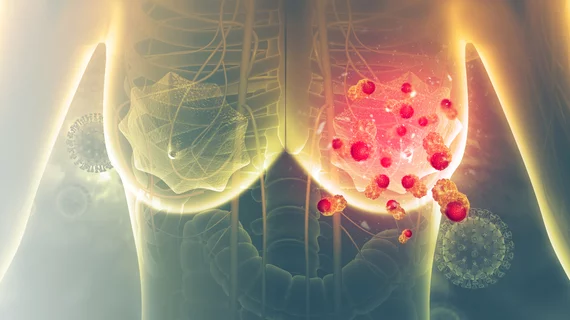Contrast-enhanced mammography is as effective as MRI for staging newly diagnosed breast cancer and can serve as a solid alternative for those facing barriers to the latter.
That’s according to a new prospective, single-center study from the University of Southern California, published Thursday in Clinical Imaging. Magnetic resonance has served as the gold standard for evaluating new breast cancers or additional disease, given its “superior” sensitivity, USC experts noted. However, it can pose new problems that include high costs, claustrophobia, and allergies to gadolinium imaging agents.
Contrast-enhanced spectral mammography utilizing iodine offers a sound alternative, illuminating lesions otherwise invisible on a regular mammogram. Testing it out on a multi-ethnic group of patients, enhanced mammography scored higher specificity and positive-predictive value than MRI, which is prone to overcalling benign lesions.
“This prospective data, from predominantly underrepresented minority patients with newly diagnosed [invasive breast cancer], shows that [contrast-enhanced spectral mammography] is comparable to MRI in evaluating index and additional lesions with similar sensitivity and improved specificity,” USC Keck School of Medicine radiologist Sandy Lee, MD, and co-authors wrote Aug. 26. “CESM can potentially be a reliable alternative to the Hispanic and African American women when there are contraindications to MRI or MRI is unavailable.”
The Los Angeles-based institution conducted its investigation between 2017-2020, incorporating 41 women with invasive breast cancer, about two-thirds of whom were Black or Latina. After their breast cancer diagnosis, subjects underwent both MRI and mammography with contrast. MRI scored more than 96% sensitivity spotting malignant lesions compared to 93% for mammography, while predictive value for contrast mammo was 96% vs. about 82% for magnetic resonance. Mammography also recorded a higher specificity, while there were similar findings on tumor size to surgery and malignancy detection.
Lee and co-authors cautioned that their study is limited by its small sample size. They also noted some drawbacks to contrast-enhanced spectral mammography, such as iodine side effects and a higher degree of radiation compared to 2D mammo.

